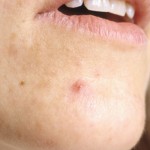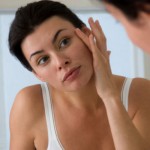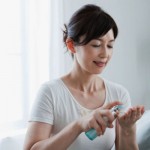Great skin year after year
Your skin can reveal the stories of your life, from the fabled glow of pregnancy to the less-welcome spots that surface from sun damage. You hear a lot about how to protect your skin from the sun’s rays, but there are many other simple health moves that can keep your exterior in fabulous shape, decade after decade.
Your 30s: Beat acne bumps
Hormone-related skin problems aren’t just for teens. Surging progesterone and testosterone levels before your period can cause adult acne to erupt around the mouth, chin, and nose. And hormonal stress can exacerbate  eczema—dry, irritated skin, often on the face and hands.
eczema—dry, irritated skin, often on the face and hands.
To treat adult acne, which tends to flare up in the 30s and is more inflammatory than teen blackheads and whiteheads, derms often prescribe benzoyl peroxide and retinol or Retin-A, says Gary Goldenberg, MD, an assistant professor of dermatology at Mt. Sinai School of Medicine, in New York City. Soothe eczema by using gentle, fragrance-free cleansers; if the problem persists, you may need a prescription for a topical corticosteroid.
Your 30s: Baby your skin
Ready to start a family? Your skin may be clearer than ever while you’re pregnant, thanks to abundant estrogen. But the hormonal flux of pregnancy can create a host of skin issues, such as melasma (dark discolored splotches on the face), which should fade after delivery.
If it bothers you, your doc may prescribe a cream with lightening agents to fade the spots. Also common: an itchy rash called PUPPP (pruritic urticarial papules and plaques of pregnancy), which may show up in the third trimester. If cool baths and moisturizers don’t relive itching, you may need a steroid cream or oral antihistamine.
Your 40s: Check yourself
In middle age, damage done to your skin decades earlier starts to show up. This can include the first signs of skin cancer.
The good news: when caught early, it’s 99 percent treatable. So monthly self-checks for moles or anything suspect are smart. In front of a mirror, examine your entire body, from your scalp (use a handheld mirror) to the soles of your feet.
are smart. In front of a mirror, examine your entire body, from your scalp (use a handheld mirror) to the soles of your feet.
Your 40s: Pick the right products
Consider a prescription for a retinoid like tretinoin to minimize signs of aging such as uneven skin tone, wrinkles, and age spots.
Your 40s: Erase redness
If you’re plagued by redness, spider-like blood vessels, and small bumps on your face, your derm may diagnose rosacea, a common skin condition often triggered by sun exposure, stress, alcohol, spicy foods, and hot weather. It’s more likely to develop with age, says Laura E. Skellchock, MD, a dermatologist in Boca Raton, Florida.
Experts recommend sensitive-skin products if you’re prone to flare-ups, green-tinted makeup to camouflage redness, and over-the-counter antiredness serums with caffeine.
Your 40s: Banish problem spots
It’s not uncommon for 40-something women to develop actinic keratosis—dry, red, flaky spots, often on the  forehead, cheeks, or nose, Dr. Goldenberg says. Another result of sun damage, they can become cancerous if not removed, so see your doc ASAP if you think you may have one.
forehead, cheeks, or nose, Dr. Goldenberg says. Another result of sun damage, they can become cancerous if not removed, so see your doc ASAP if you think you may have one.
Two other common (and often similar-looking) problem spots: seborrheic keratosis (warty, yellow-brown growths, usually on the back and chest) and skin tags (often on the eyelids, underarms, neck, or groin). These two may look unpleasant, but they’re benign and can also be removed in the doctor’s office.
Your 50s+: Quench the thirst
As your estrogen level drops and oil production decreases, skin can get thinner, drier, and often itchier. Bathing too often, with water that’s too hot, or with harsh or excess soap, can make things worse. Hypothyroidism (an underactive thyroid gland), which becomes more common over age 50, can also cause overly dry, itchy skin, so see your doc to rule it out if you have other common symptoms such as fatigue, depression, unexplained weight  gain, or muscle aches.
gain, or muscle aches.
Your 50s+: Love your legs
Roughly half of all women over 50 have a few varicose or spider veins (enlarged blood vessels visible on the skin), usually on the legs. Gravity, aging, and genetics all play a role, but women who are on their feet a lot are at greater risk. Fixes include sclerotherapy (sealing off the veins) and laser treatments.
Varicose or spider veins very rarely indicate a circulatory problem, but if one becomes swollen, warm, red, or tender, or if a rash or sore develops near it, see a doctor to rule out a dangerous blood clot. To help keep spider and varicose veins at bay, avoid sitting with legs crossed for long periods of time, exercise regularly, and maintain a healthy weight.